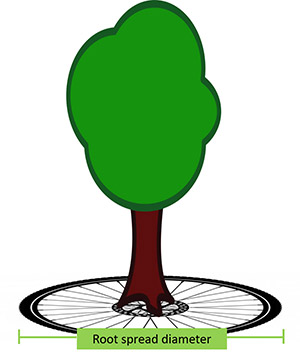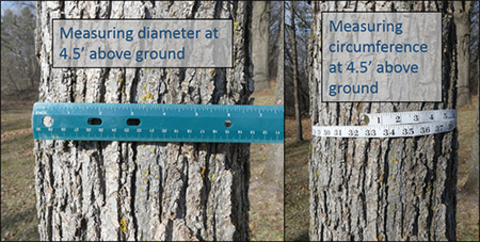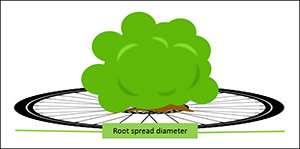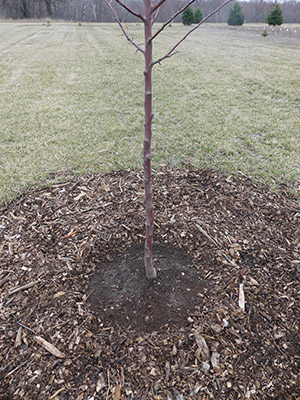Quick facts
- Water established trees and shrubs with overhead sprinklers.
- Apply a deep watering over the entire root zone area until the top 6 to 9 inches of soil are moist.
- Avoid light watering as this promotes shallow root systems that are susceptible to summer heat and drought stress.
- Water early in the morning to minimize water loss due to evaporation and wind drift.
- Mulching around the base of trees and shrubs helps them take in water and stay healthy.
During periods of consistent rainfall, a well-sited and well-established tree or shrub will need little additional water. But during long periods without rainfall, established trees and shrubs can suffer or die without timely irrigation.
During periods of drought, you may need to water your trees and shrubs more often to ensure the health and survival of these long-lived plants.
How woody plants use water
As you stand in your garden or landscape, you are surrounded by water on the move within plants. This is due to a solar-powered process called transpiration.
- Water is absorbed from the soil into the roots of plants.
- Transpiration pulls streams of water molecules up into the plant through inter-connected tissues within roots, stems and leaves.
- Water moves from the leaves into the atmosphere as an air-cooling vapor through tiny openings called stomata found primarily on the bottom surface of leaves.
- Transpiration lifts enormous quantities of water against gravity to the tops of trees.
- Transpiration is the main path of water loss in plants.
- At least 90% of the water in plants is lost from leaves through transpiration.
- The remaining portion of water is lost through other plant parts or is used during the processes of plant growth and development.
Water is vital to plant growth and development.
- Comprises 80-90% of actively growing tissues (leaves, root tips).
- Makes up about 50% of the woody portions (trunks, stems, large roots) of trees and shrubs.
- Fuels photosynthesis and other processes involved in plant growth, flowering and seed production.
- Helps defend against pests and stresses.
- Transports nutrient minerals and other solutions throughout the plant.
- Gives firmness and form to leaves, buds, flowers and new succulent stem tips.
- Cools the plant as water vapor is lost during transpiration.
How, when and how much to water
Figuring out how far a tree's roots spread helps to determine the area you need to water and how much water is needed for an individual tree.
- The best time to water a tree or shrub is when the top 6 to 9 inches of soil in the root zone are dry.
- Using a spade or hand trowel, dig a small hole under the plant canopy and feel the soil.
- If the soil is cool and moist 6 to 9 inches below the surface, no water is needed.
- If the soil is dry, it is time to water.
- The first visible symptom in trees and shrubs that indicates a need to water is temporary wilting.
- During temporary wilting, leaves wilt and droop during the day but recover at night and appear normal again the following morning.
- Wilting first occurs in the top center portion of an established tree or shrub canopy and can be difficult to spot, especially in a mature, tall shade tree.
- Monitoring soil dryness and watering when the top 6 to 9 inches of soil are dry is more effective.
Irrigation schedules
Seasonal temperature shifts, soil characteristics, sloping terrain and exposed sites with higher temperatures or winds can all affect irrigation schedules.
- Soils will remain moist for longer periods of time in the cool days of spring and fall.
- Soils dry much more quickly in summer as temperatures and transpiration rates increase.
- You may want to test your soil’s water holding capacity in both spring and summer so that you can adjust the frequency of watering as the growing season progresses.
- Sandy soils hold less water and may need smaller irrigation amounts applied more often than loam or clay soils.
- For instance, if a clay soil requires one inch of water once a week, a sandy soil may require 1/2" of water applied every 3 to 4 days.
- On sloped sites with clay or silt soils, water may run off of the soil surface before the desired amount of water has infiltrated into the soil.
- Avoid this by watering more often for less time. The extra time between watering will allow water to soak into the soil.
- Apply mulch to absorb and hold moisture for slow-absorbing soils to help avoid runoff.
Under-watering and over-watering
Applying the proper amount of water is important to tree and shrub health.
- Under-watering causes a decline in the growth and health of trees and shrubs.
- Over-watering is wasteful and can be just as harmful to tree and shrub health as under-watering, particularly in clay and compacted soils.
- Pore spaces between soil particles are shared by water and oxygen.
- Over-watering causes pore spaces normally occupied by oxygen to become filled with water.
- It may cause root suffocation and a decline in tree or shrub health.
Watering plan
A watering routine that provides the correct amount of water to trees and shrubs is unique to every landscape. To determine the best watering plan for your landscape:
- Choose a time when the top 6 to 9 inches of soil are dry and there is no rain predicted for several days.
- Set several shallow containers (pie tins, cake pans, shallow cans, etc.) across the area to be watered. These will serve as a reservoir that can be used to measure one inch of water.
- Use a sprinkler to water the area until there is an average of one inch of water in each container.
- Record how long it took to gather this amount of water.
- Wait two hours and then slice into the soil with a sharp spade or shovel. Create a big enough opening to reach in with your hand and feel the soil 6 to 9 inches below the ground. If the soil is cool and moist at this depth, the irrigation is appropriate.
- If you need to apply more water, add another half-inch and check again to see if the top 6 to 9 inches of soil are moist.
- Continue this process until the top 6 to 9 inches of soil have received water.
- Record the total irrigation time for future reference. Water for this length of time whenever you water.
- Over the next several days, check the moisture level of your soil 6 to 9 inches below the surface of the ground every other day.
- If the moisture level is still adequate, the soil will feel cool and damp.
- Refill the hole and repeat this step every other day until the soil feels dry.
- Record the number of days it took for the top 6 to 9 inches of soil to dry. This provides you with the number of days between watering in the absence of rain.
Root spread
The growth pattern of a tree’s root system resembles spokes of a bicycle tire with roots radiating through the soil from a central point below a tree trunk.
Root spread will continue in actively growing trees until roots hit some kind of barrier to growth (paved roads, sidewalks, highly compacted soil, low oxygen levels, etc.). In order to water trees effectively, it is necessary to know how far roots have spread.
- Roots grow and spread quickly in young and middle-aged trees with trunk diameters of 10 inches or less.
- Root spread slows in larger older trees with trunk diameters of 10 inches or greater.
- Trunk diameter or trunk circumference are the most accurate measurements for estimating root spread.
- To measure the trunk's diameter use a ruler or yardstick.
- To measure the trunk's circumference use a measuring tape.
- Be sure to measure the diameter and circumference 4.5 feet above the ground.
- After measuring trunk diameter or circumference, use the root spread diameter listed in the table below to estimate root zone width for irrigation purposes.
Trunk diameter and circumference for estimating root spread of trees
| Trunk diameter | Circumference of tree | Root spread diameter |
|---|---|---|
| 2 inches | 6-7 inches | 12-14 feet |
| 4 inches | 12-13 inches | 20-22 feet |
| 6 inches | 18-19 inches | 26-28 feet |
| 8 inches | 25-26 inches | 28-30 feet |
| 10 inches | 31-32 inches | 30-32 feet |
| 12 inches | 37-38 inches | 32-34 feet |
| 14 inches | 44-45 inches | 32-34 feet |
| >16 inches | >50-51 inches | 34-36 feet |
Although a tree’s root system can extend down several feet below the soil line, most of the small feeder roots responsible for water uptake are located in the top 12 to 18 inches of soil. These 12 to 18 inches of soil within the root spread area make up the root zone and it serves as a reservoir of water for trees between rainfall or irrigation.
There is no rainfall for extended periods, soils will dry first at the ground surface. If lack of rain continues, drying will progress deeper into the soil and you will need to water the root zone.
- As with trees, shrub roots radiate out and down from below the base of the shrub until they hit barriers to growth.
- The larger the shrub canopy, the farther the roots will spread.
- Root systems of established shrubs are approximately 1.5 to 3.5 times as wide as the plant.
- The majority of small feeder roots responsible for water uptake are near the soil surface, in the top 12 to 18 inches of soil.
Mulching
Mulching trees and shrubs maximizes water uptake and tree health.
When trees and shrubs are grown in turf, competition for nutrients, water and space occurs below ground between turf roots and woody plant roots. Turf wins because its dense fibrous root system prevents woody plants from producing water-absorbing roots in the top few inches of soil. As a result, woody plants grow more slowly in turf areas than in mulched or bare soil areas.
Woody plant growth and health improve when turf growing beneath tree and shrub canopies is removed and replaced with organic mulch.
- Get rid of grass and weeds around the base of the plant.
- Start mulch 12-18 inches from the base of the trunk or stems.
- Beyond this area of bare soil, place a 3-inch-deep layer of organic mulch, such as wood chips, out to the edge of the tree or shrub canopy.
- Replace organic mulch every few years as it decomposes.
Mulching around trees and shrubs with organic materials benefits trees and shrubs in several ways.
- Decreases water evaporation from soil.
- Acts like a sponge that prevents runoff around plants growing in heavy clay soils or on sloped sites.
- Helps to control seed germination and growth of weeds.
- Insulates soil and buffers extreme summer and winter soil temperatures.
- Reduces soil compaction from mowing equipment.
- Prevents damage to stems and trunks by lawn mowers and weed cutters.
- Improves soil health as it decomposes.
Don't make the mulch layer too deep as it can cause problems such as:
- Root production and growth in the mulch. This often results in circling and stem-girdling roots.
- Preventing movement of rain or irrigation water into the soil around trees and shrubs. This can result in roots drying out and plant stress.
- Reducing oxygen levels around roots, causing root suffocation.
- Keeping poorly drained soils too wet, which favors root rot development.
- Keeping bark too wet when piled around trunks and stems. This may lead to bark decay.
- Creating habitat for rodents that chew bark and girdle trunks and stems.
Reviewed in 2022






